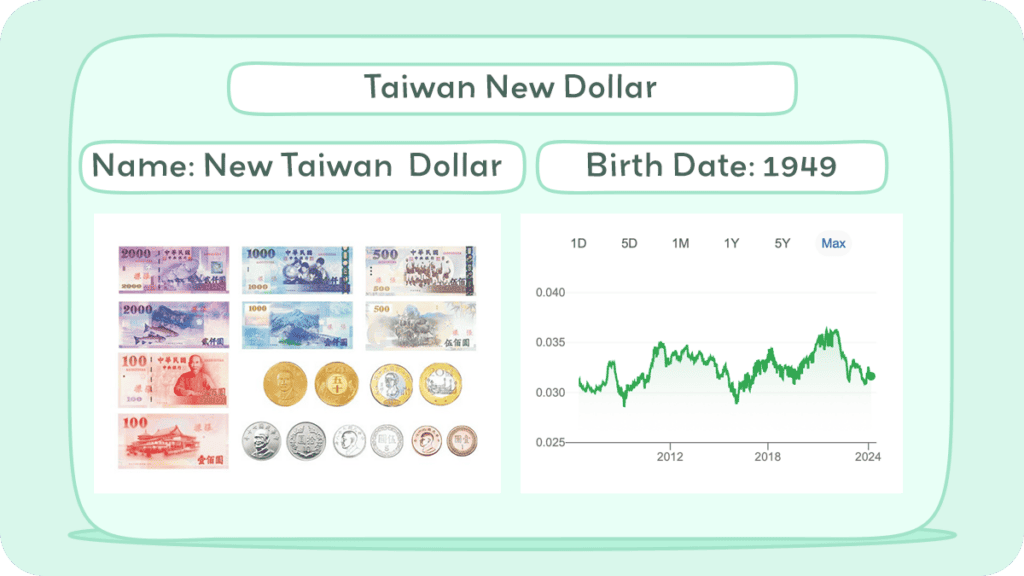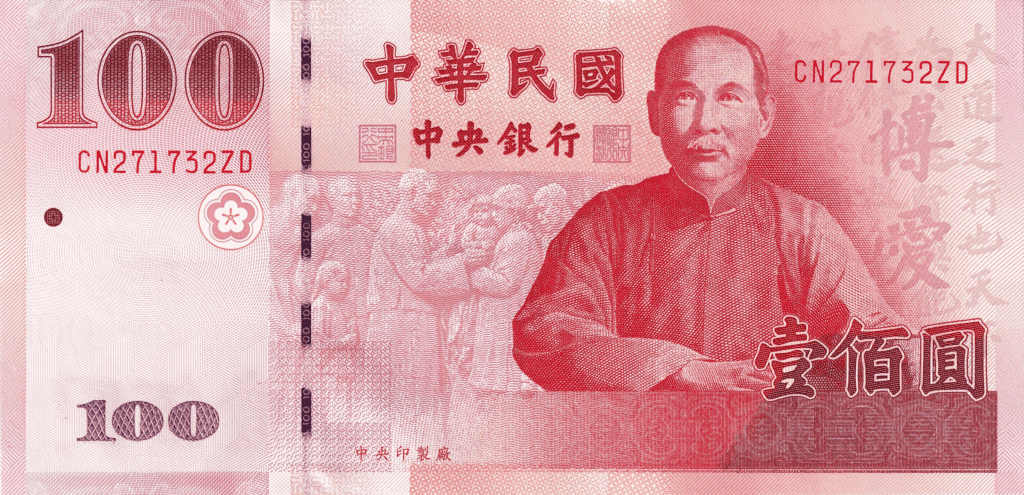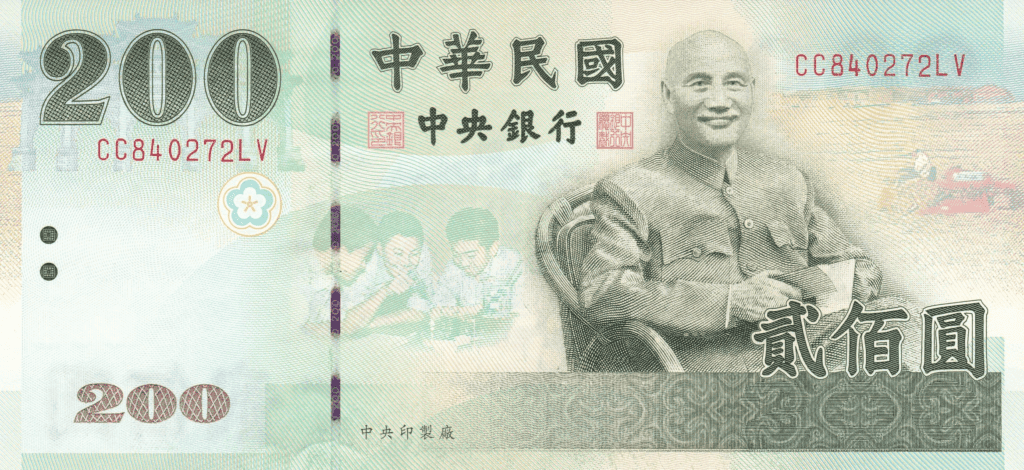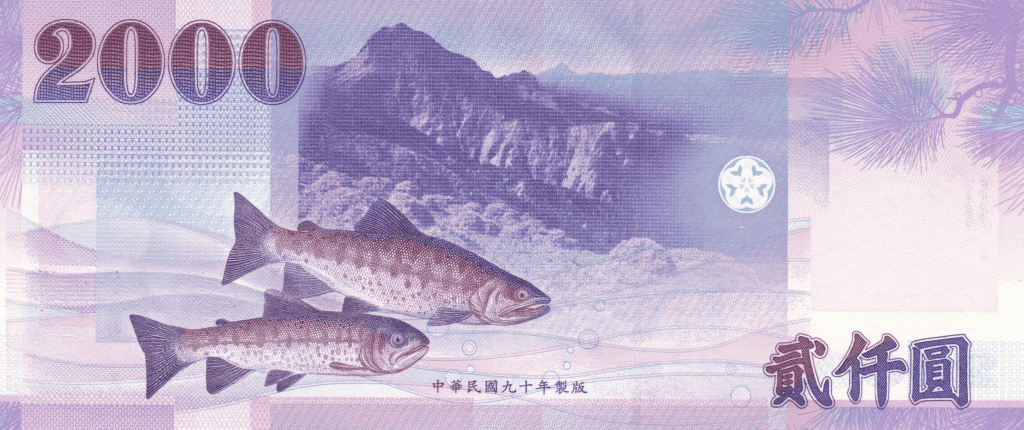The official currency of Taiwan is the New Taiwan dollar (NTD or TWD). It has been the currency of Taiwan since 1949 when it replaced the Old Taiwan dollar. One New Taiwan dollar was equal to 40,000 old dollars.

The New Taiwan dollar comes in both banknotes and coins. The banknotes come in denominations of NT$100, NT$200, NT$500, NT$1000, and NT$2000. The coins come in denominations of NT$1, NT$5, NT$10, NT$20, and NT$50. The coins are made of copper, aluminum, and nickel, while the banknotes are made of paper.
This article delves into the history and facts surrounding the New Taiwan dollar (TWD), the official currency of Taiwan.
Historical Journey of Taiwan Currency
Taiwan has a rich history of currency dating back to the early 17th century when Spanish and Dutch colonizers introduced silver coins to the island. Over the years, Taiwan’s currency has undergone significant changes, with the most significant being the introduction of the New Taiwan dollar (TWD) in 1949.
Before the introduction of the TWD, Taiwan used the Old Taiwan dollar, which was first issued by the Bank of Taiwan in 1946. The Old Taiwan dollar replaced the Japanese yen, which was used during Japan’s occupation of Taiwan. However, the Old Taiwan Dollar was plagued by inflation, and by the late 1940s, it had lost much of its value.
In 1949, the Taiwan Provincial Government replaced the Old Taiwan dollar with the New Taiwan dollar at an exchange rate of 40,000 to 1. The Central Bank of the Republic of China became the sole issuer of the New Taiwan dollar, and it has remained the official currency of Taiwan ever since.
The New Taiwan dollar has undergone several changes since its introduction. In 2000, the Central Bank of the Republic of China issued a new series of banknotes that featured images of Taiwan’s natural scenery and cultural heritage. In 2011, the bank issued a new coin series that featured images of Taiwan’s endemic species.
Today, the New Taiwan dollar is a stable and widely accepted currency. It is used not only in Taiwan but also in some parts of China, where it is accepted as legal tender in certain areas. With its rich history and stable value, the New Taiwan dollar is an essential part of Taiwan’s economy and culture.
History of Coins
The New Taiwan dollar, introduced on June 15, 1949 by the Bank of Taiwan, replaced the Old Taiwan dollar to combat hyperinflation caused by the Chinese Civil War. This currency transition occurred with a conversion ratio of 40,000 Old Taiwan dollars to 1 New Taiwan dollar.
The introduction of the New Taiwan dollar aimed to stabilize the economy as the Nationalists retreated to Taiwan, bringing China’s gold reserve with them in February 1949.
Despite the New Taiwan dollar serving as the de facto currency, early legal documents still recognized the silver yuan, valued at NT$3, as the official currency, a status unaltered by inflation and rendering it a notional currency.
In 1991, when temporary provisions were lifted, Taiwan lacked a legal national currency until 2000 when the Central Bank of China took over currency issuance from the Bank of Taiwan, making the New Taiwan dollar the legal tender and initiating the circulation of new banknotes.
The New Taiwan dollar has experienced fluctuating exchange rates with the US dollar, varying from less than ten-to-one in the 1950s to over forty-to-one in the 1960s, and stabilizing around twenty-five-to-one by 1992. As of July 2021, the exchange rate was approximately NT$27.93 per US dollar.
Taiwan circulates coins in denominations of 50¢, NT$1, NT$5, NT$10, NT$20, and NT$50, featuring designs that include prominent figures like Chiang Kai-shek, Chiang Ching-kuo, Sun Yat-sen, and Mona Rudao, as well as symbols like the Mei Blossom.
The Central Mint produces coins, while the Central Engraving and Printing Plant prints notes, both under the oversight of the Central Bank. Coin values, compositions, and designs have evolved, reflecting Taiwan’s cultural and historical identity.
History of Bills
The New Taiwan dollar introduced a new series of banknotes in July 2000, marking the currency’s official adoption over the silver yuan. This series includes denominations of NT$100, NT$200, NT$500, NT$1000, and NT$2000.
The NT$200 and NT$2000 notes are less commonly used, often due to consumer preference for more readily available denominations and payment methods, and possibly due to limited government promotion.
This series can be distributed through government interactions with the public, like at post offices or banks.
There’s also speculation regarding the political implications of the banknote designs, particularly concerning the inclusion of anti-Communist revolutionary Chiang Kai-shek on less circulated notes, which some see as a way to subtly diminish his presence on Taiwan’s currency amidst political sensitivities.
Inflation and Buying Power of Taiwan Currency

The buying power of the Taiwan currency, also known as the New Taiwan dollar (NTD), has been affected by inflation in recent years. According to Bloomberg, Taiwan is expected to tolerate stronger currency and inflation.
This decision comes as the NTD is the best-performing Asian currency this year. However, high inflation continues to lower purchasing power in the US and Europe, and with Mainland China’s economy yet to recover fully, it remains a challenging time for Taiwan’s economy.
As of February 25, 2024, the NTD has been depreciating against the US dollar. The NTD closed at NT$29.66 against the US dollar, or 0.51 percent lower, its weakest since June 17, 2020, according to Taipei Times.
So far this year, the NTD has depreciated 6.64 percent against the US dollar, second only to the Japanese yen’s depreciation of 11.81 percent among major Asian currencies.
The depreciation of the NTD against the US dollar has affected Taiwan’s exports and purchasing power. However, the rising NTD comes with risks and rewards.
Rallied by booming exports, the NTD is attempting to crack a level that has held for almost 25 years. Taiwan’s policymakers could slow the currency’s gains as it approaches NT$27.501 per US dollar, a level it last reached in March 1997.
Overall, the buying power of the Taiwan currency has been affected by inflation and depreciation against the US dollar. However, the government’s decision to tolerate stronger currency and inflation may help stabilize the NTD’s value.
New Taiwan Dollar
The initial $500 and $1000 notes issued without a holographic strip were withdrawn from circulation on August 1, 2007, with a grace period for exchange at banks.
Additionally, a commemorative NT$100 note was issued on January 6, 2011, to celebrate the 100th anniversary of the Republic of China’s founding. This note is similar in design to the standard NT$100 note but includes special wording to mark the centennial.
The banknotes feature various cultural and natural elements:
NT$100

The NT$100 note is red and highlights Sun Yat-sen and the Chung-Shan Building, with a Mei flower watermark.
NT$200

The NT$200 note, less commonly circulated, is green and features Chiang Kai-shek with themes of land reform and education, and an orchid watermark.
NT$500

The NT$500 note, in brown, showcases youth baseball, the Formosan sika deer, and Dabajian Mountain, with a bamboo watermark.
NT$1000

The NT$1000 note is blue, focusing on elementary education, the Mikado pheasant, and Yushan (Jade Mountain), with a chrysanthemum watermark.
NT$2000

The NT$2000 note, also limited in circulation, is purple and displays FORMOSAT-1 and technology themes, with the Formosan landlocked salmon, Mount Nanhu, and a pine watermark.
Currency Usage in Taiwan
Taiwan has its currency, the New Taiwan dollar (NTD or TWD). It is the only currency accepted in the country. You can exchange your currency for NTD at banks, exchange offices, or at the airport.
Is USD accepted in Taiwan?
While some tourist-oriented businesses may accept US dollars, it is recommended to use NTD for all transactions in Taiwan. You may find it difficult to use US dollars outside of major tourist areas. It’s important to note that you will likely receive change in NTD even if you pay in USD.
When traveling to Taiwan, it’s a good idea to have some cash on hand, as many smaller businesses and street vendors may not accept credit cards. You can withdraw NTD from ATMs located throughout the country. Major credit cards, such as Visa and Mastercard, are widely accepted in larger cities and tourist areas.
Overall, it’s best to use NTD for all transactions in Taiwan to avoid any confusion or inconvenience. Make sure to exchange your currency before arriving in Taiwan to ensure you have enough cash on hand.
Exchanging Currency in Taiwan
If you are planning a trip to Taiwan, it’s important to know how to exchange your currency. Here are some tips on exchanging currency in Taiwan.
Where can I exchange Taiwan currency?
In Taiwan, you can exchange your currency at several locations. Banks are the most popular option, offering competitive exchange rates and operating during standard business hours. Another convenient choice is currency exchange offices, which are often found in tourist areas and provide flexible hours.
While many hotels also offer currency exchange services, their rates may not be as competitive. Additionally, ATMs present an easy way to withdraw cash, though using an ATM not affiliated with your bank might incur a fee.
What to know before exchanging currency in Taiwan
Before you exchange your currency in Taiwan, here are some things you should know:
- Exchange rates: Exchange rates can vary from place to place, so it’s a good idea to shop around for the best rate.
- Fees: Some places may charge a fee for exchanging currency, so be sure to ask about any fees before exchanging your money.
- Identification: You will need to show your passport or other form of identification when exchanging currency in Taiwan.
- Currency restrictions: There are no currency restrictions in Taiwan, so you can exchange as much money as you need.
- Exchange receipts: Be sure to keep your exchange receipts in case you need to exchange your money back to your original currency.
By following these tips, you can exchange your currency in Taiwan with ease.
Choosing Between USD and Taiwan Currency
When traveling to Taiwan, you may be wondering whether to use USD or Taiwan currency. Here are some factors to consider:
Exchange Rate
The exchange rate between USD and Taiwan currency fluctuates daily. It’s important to check the current rate before making any transactions. Keep in mind that exchange rates can vary depending on the location and institution.
Convenience
While USD is widely accepted in major tourist areas, it’s still best to have some Taiwan currency on hand for smaller transactions. ATMs are widely available, and many accept foreign cards. However, it’s important to check with your bank for any international transaction fees.
Fees
When using a credit card, be aware of foreign transaction fees and currency conversion fees. Some credit cards offer no foreign transaction fees, so it’s worth checking with your bank to see if they offer this service.
Tips
When exchanging currency, it’s important to compare rates and fees from different institutions. You can also check online exchange sites for the latest rates. It’s also a good idea to have a mix of Taiwan currency and USD for convenience.
Cost of Living in Taiwan
If you’re planning to move to Taiwan, it’s important to understand the cost of living. Compared to the United States, the cost of living in Taiwan is generally lower.
According to Numbeo, a single person’s estimated monthly costs without rent are around $780 USD. Rent in Taiwan is also significantly cheaper, with an average of 69.4% lower rent prices compared to the United States.
When it comes to food, Taiwan has a wide variety of affordable options. Street food is a popular and inexpensive option, with vendors selling everything from dumplings to bubble tea. In addition, there are many local markets where you can find fresh produce and other ingredients at reasonable prices.
Transportation in Taiwan is also relatively inexpensive. The public transportation system is well-developed, with a variety of options including buses, trains, and the MRT (Mass Rapid Transit). Taxis are also affordable, with fares starting at around $2.50 USD.
It’s worth noting that the cost of living in Taiwan can vary depending on where you live. Cities like Taipei and Kaohsiung tend to have higher costs of living compared to smaller towns and rural areas. However, overall, Taiwan is a relatively affordable place to live.
Don’t Get Scammed Tips
When traveling to Taiwan, it is important to be aware of potential scams when exchanging currency. Here are some tips to help you avoid being scammed:
1. Exchange Currency at Banks or Official Exchange Counters
Avoid exchanging currency with street vendors or individuals who approach you on the street. These individuals may offer a better exchange rate, but they are likely to be scammers. Instead, exchange currency at banks or official exchange counters located in airports, hotels, and shopping centers. These places offer a fair exchange rate and are less likely to scam you.
2. Check the Exchange Rate
Before exchanging currency, check the current exchange rate to ensure that you are getting a fair deal. You can easily check the exchange rate online or by using a currency converter app. If the exchange rate offered by the bank or exchange counter is significantly different from the current exchange rate, consider finding another place to exchange your currency.
3. Beware of Counterfeit Bills
Counterfeit bills are a common problem in Taiwan. To avoid receiving counterfeit bills, check the bills carefully before accepting them. Look for security features such as watermarks, security threads, and holograms. If you receive a counterfeit bill, report it to the police immediately.
4. Use New Bills
When exchanging currency, use new bills if possible. Old bills are often rejected, and some exchange counters may charge a fee for exchanging old bills. Additionally, some vendors may refuse to accept old bills, so it is best to use new bills to avoid any issues.
5. Don’t Let Anyone Count Your Money
When exchanging currency, do not let anyone count your money for you. Count the money yourself to ensure that you have received the correct amount. If you are unsure how to count the bills, ask someone at the bank or exchange counter to show you how.
By following these tips, you can avoid being scammed when exchanging currency in Taiwan. Remember to always be cautious and aware of your surroundings when dealing with money.

